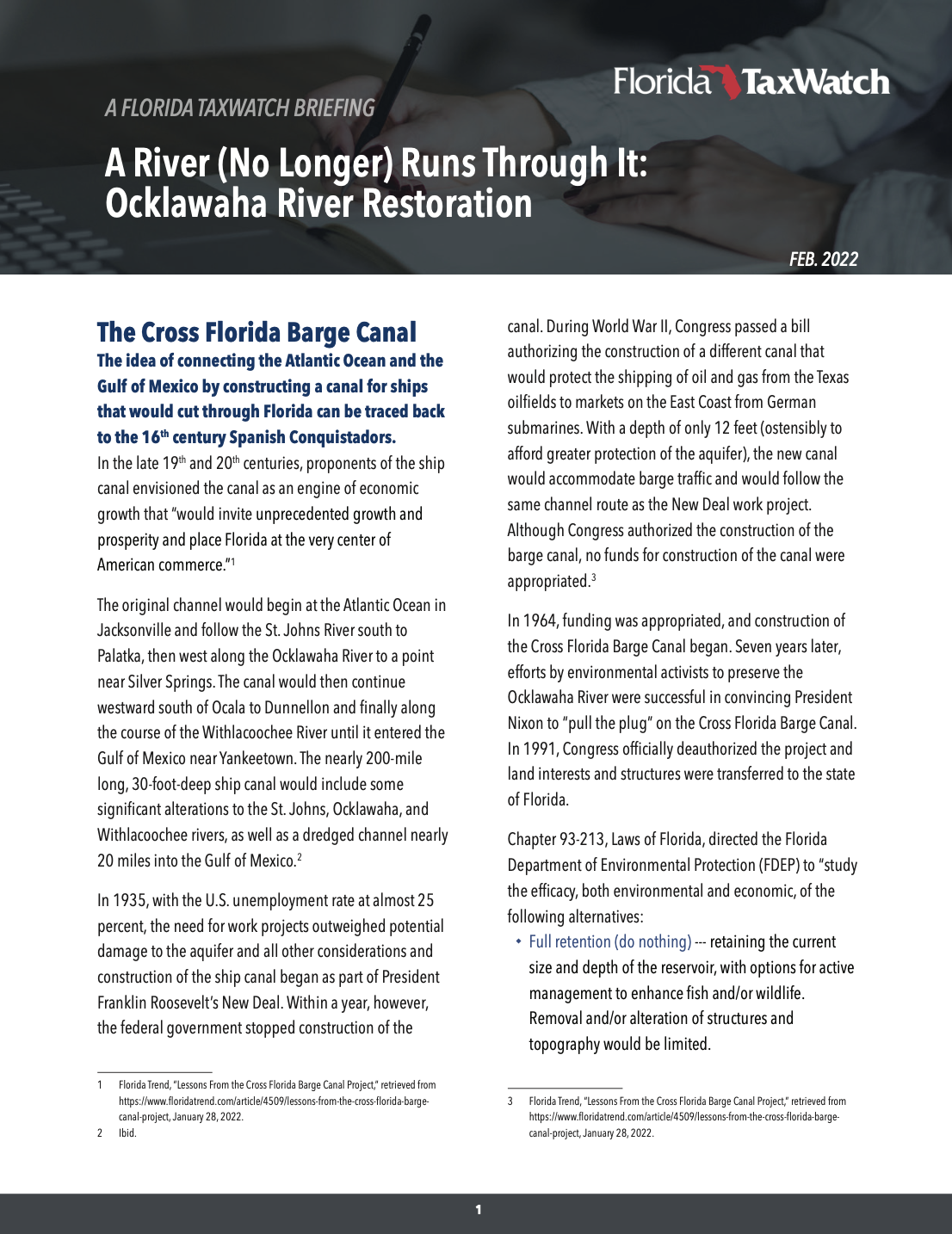A River (No Longer) Runs Through It

The construction of the Rodman Dam, now known as the George Kirkpatrick Dam, and its adjoining reservoir closed off the flow of the Ocklawaha River, resulting in the loss of 16 miles of the Ocklawaha River, the loss or flooding of 7,500 acres of forested wetlands, and the covering of more than 20 freshwater springs. The public policy debate around what to do with the Kirkpatrick Dam centers on whether the dam and reservoir should remain in place or whether the dam should be breached to restore the natural flow of the Ocklawaha River.
Currently, the dam has surpassed its 50-year life expectancy leaving it at risk for total failure. The dam is in need of maintenance and repairs estimated between $4 million - $14 million to bring it to accepted standards, as well as an estimated $364,000 in annual costs to maintain the dam and spillway. Total failure of the dam may impact 539 properties with flood damages estimated at $57 million. Collateral damage would also include damage to roadways, bridges, and other downstream structures.
Florida TaxWatch wades into this dispute to assess the options and provide policymakers with information they will need to make an informed decision regarding the future of the Ocklawaha River. Florida TaxWatch looks at two of the four alternatives that were considered in FDEP’s 1994 assessment and the USDA 2001 Final Environmental Impact Statement:
- Full retention --- involves retaining the current size and depth of the dam and reservoir, with options for active management to enhance fish and/or wildlife. Removal and/or alteration of structures and topography would be limited.
- Partial restoration --- involves restoring river hydrology and floodplain function to near preconstruction conditions by breaching the dam. Alteration and/or removal of structures and topography would be limited.
Full Retention:
The Rodman Reservoir provides between $6 million and $7 million per year to the economies of Putnam County and Marion County. Removal of the Rodman Reservoir produces negative net economic benefits over the next 20 years ranging from -$3.9 million to -$18.3 million, depending on the restoration alternative chosen.
A November 2019 study by the University of Florida analyzed the economic impacts of recreational visitors to the Ocklawaha River and Rodman Reservoir, the total economic impacts of visitor spending include employment of 356 full-time and part-time jobs, $16.23 million in added value (Gross Regional Product), $10.26 million in labor income, and $28.30 million in industry output or business revenues.
Partial Restoration:
Research suggests that if the reservoir were removed, tourism along the Ocklawaha River would increase. With more visitors, a partial restoration of the river stands to add an annual benefit of $9.1 million upon completion of the project. Restoring the natural flow of the Ocklawaha River will increase local and nonresident visitor revenues across the river system. Researchers from the University of Florida (UF) and Jacksonville University (JU) estimated that the diversification of outdoor recreational offerings and the overall improvements in the condition of the river will increase annual regional visitation by an estimated 28 percent.
The major economic argument against restoring the natural flow of the Ocklawaha River is that there will be a negative impact on fishing, for which this area is renowned. However, restoring the natural flow of the Ocklawaha River may actually improve fishing due to improved water quality. With an estimated price tag of $25.8 million over ten years, the projected ten-year return on investment for the restoration of the Ocklawaha River is calculated at 7.6 percent or a $1.76 return on every $1.0 invested. The cumulative net benefit of restoring the flow of the Ocklawaha River over ten years is estimated to be $47.2 million.
Recommendations:
Florida TaxWatch thinks that time is now to decide the future of the Kirkpatrick Dam and Rodman Reservoir. First, the costs of retention or restoration are not exorbitant. Repairing and maintaining the dam and reservoir will require as much as $14 million to meet accepted standards for dam safety, and annual maintenance of an estimated $234,000 thereafter. The cost of the “partial restoration” alternative, estimated at $25.8 million, would be spread over a multi-year period. Due to new (2020) federal dam safety requirements, these costs are likely to increase when updated estimates are developed.
Second, moneys are available to fund either option. Through the federal $1.2 trillion Infrastructure Investment and Job Act, Florida will receive an estimated $19.1 billion over five years to improve its public infrastructure, and other federal funds may be made available for dam and barrier removal and restoration after removal.
Florida TaxWatch thinks that what was a good idea in 1994 is a good idea in 2022. Florida TaxWatch supports the breaching of the Kirkpatrick Dam and the partial restoration of the natural flow of the Ocklawaha River. Florida TaxWatch recommends the legislature appropriate funding to bring about this partial restoration. To do otherwise would be a dam shame.